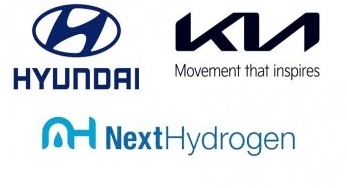Jae-Hyuk Oh is vice president and head of Hyundai Motor Group’s Energy Business Development Group, and Raveel Afzaal is president and CEO of Next Hydrogen.
Hyundai Motor, Kia and Next Hydrogen have signed a memorandum of intent to develop an advanced water-alkali electrolysis system to make green hydrogen production economically viable.
The partners expect to develop more efficient stack solutions for this system and explore the potential for future technological applications and commercialization opportunities.
July 09, 2021. Hyundai Motor and Kia Corporation have signed a memorandum of intent with Next Hydrogen Corporation, a Canadian company specializing in water electrolysis technology and acting as a subsidiary of Next Hydrogen Solutions Inc. The parties will join forces to accelerate the transition to a global hydrogen society through the cost-effective production of green hydrogen.
Under the terms of the agreement, the companies will jointly develop a water-alkali electrolysis system[1] and related stacks (electrolysers) for the economically viable production of green hydrogen, and explore new opportunities for commercial use and technological applications.
At present, the production of green hydrogen results in time and financial costs. In this regard, Hyundai Motor, Kia and Next Hydrogen are looking for ways to make it more cost-effective, taking into account regional climate and environmental considerations. This time, the companies, expanding their knowledge by examining the advantages and disadvantages of different aqueous electrolysis technologies, will investigate the capabilities of the aqueous-alkali electrolysis system in comparison to other similar technologies.
Compared to other aqueous electrolysis methods, aqueous-alkali electrolysis technology is considered one of the most thoroughly tested and studied, since it has undergone a great deal of research and development. In addition, the production of large volumes of hydrogen with relatively inexpensive catalysis reduces equipment costs.
The goal of the method is to improve the stack technology underlying the water-alkali electrolysis system in order to reduce the cost of building and maintaining this system. A key advantage of the project is that such technology will enable the development of a new electrolyzer capable of operating at high current densities[2] and producing cost-effective “green” hydrogen.
The next-generation electrolyzer will use Hyundai Motor and Kia components related to electrodes, bipolar plates and current collectors in combination with Next Hydrogen design technology. Hyundai Motor and Kia will also evaluate the new stack test results. The first trial is scheduled for 2022. In addition, the companies will explore the potential for technological applications and commercialization opportunities.
“We are excited to partner with Next Hydrogen, a company specializing in unique water electrolysis technology. For our hydrogen business, this collaboration will be another step forward and the first step in entering the water-alkali electrolysis market,” said Jae-Hyuk Oh, vice president and group head of energy business development for Hyundai Motor Group. – We are confident that our technology will be a perfect match for Next Hydrogen. This synergy will help us achieve our common goal of providing customers with affordable green hydrogen.”
“The innovative development of water electrolysis technology with the Next Hydrogen stack is the ideal solution for economically viable green hydrogen production,” said Raveel Afzaal, president and CEO of Next Hydrogen. – We appreciate the opportunity to work with Hyundai Motor and Kia because of their demonstrated industry leadership and technological leadership in this area. Our partnership should accelerate the work of creating an incredibly wide range of cleaner vehicles around the world.”
Compared with other types and production methods of hydrogen, hydrogen, traditionally called “green” hydrogen, is one of the cleanest options for this fuel. It produces no carbon emissions, and the necessary aqueous electrolysis uses energy from renewable sources, such as offshore wind farms, during production. “Green” hydrogen, which is also called “fuel of the future” because of its environmental friendliness, has the potential to revolutionize global industry and the transport sector.
In addition to “green” hydrogen, there is “gray” hydrogen, which is produced using fossil hydrocarbons and releasing carbon dioxide. Similarly, “blue” hydrogen is produced, but in this case no CO2 is released into the atmosphere thanks to carbon capture technology. Instead, the carbon dioxide is stored in special underground storage facilities.
Due to the high cost of hydrogen production, many global companies are looking for ways to improve their aqueous electrolysis technologies to make green hydrogen production more profitable. The common pursuit of this goal has led Hyundai Motor Group and Next Hydrogen to join forces to develop technology that can create a cost-effective solution.
Hyundai Motor Group, which includes Hyundai Motor and Kia, recently unveiled a new brand, HTWO, dedicated to the group’s world-leading hydrogen fuel cell systems. The group is stepping up efforts to develop a next-generation hydrogen fuel cell system that can be used for various modes of transportation, including automobiles and urban air mobility (UAM), marine vessels, rail vehicles and more.
[1]Water-alkali electrolysis system: a method of hydrogen production in which water is electrolyzed with an alkaline electrolyte – such as potassium hydroxide (KOH) or sodium hydroxide (NaOH).
[2]High-density current: The more electricity available, the more hydrogen a water-alkali electrolysis system can produce. Therefore, the system is equipped with a stack that maintains a high-density current. This makes it possible to achieve greater economic efficiency by producing increased amounts of hydrogen without increasing the footprint.
